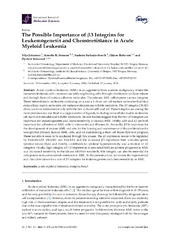The possible importance of β3 integrins for leukemogenesis and chemoresistance in acute myeloid leukemia
Peer reviewed, Journal article
Published version

Åpne
Permanent lenke
https://hdl.handle.net/1956/19801Utgivelsesdato
2018-01-15Metadata
Vis full innførselSamlinger
Originalversjon
https://doi.org/10.3390/ijms19010251Sammendrag
Acute myeloid leukemia (AML) is an aggressive bone marrow malignancy where the immature leukemia cells communicate with neighboring cells through constitutive cytokine release and through their cell surface adhesion molecules. The primary AML cells express various integrins. These heterodimeric molecules containing an α and a β chain are cell surface molecules that bind extracellular matrix molecules, cell surface molecules and soluble mediators. The β3 integrin (ITGB3) chain can form heterodimers only with the two α chains αIIb and αV. These integrins are among the most promiscuous and bind to a large number of ligands, including extracellular matrix molecules, cell surface molecules and soluble mediators. Recent studies suggest that the two β3 integrins are important for leukemogenesis and chemosensitivity in human AML. Firstly, αIIb and β3 are both important for adhesion of AML cells to vitronectin and fibronectin. Secondly, β3 is important for the development of murine AML and also for the homing and maintenance of the proliferation for xenografted primary human AML cells, and for maintaining a stem cell transcriptional program. These last effects seem to be mediated through Syk kinase. The β3 expression seems to be regulated by HomeboxA9 (HoxA9) and HoxA10, and the increased β3 expression then activates spleen tyrosine kinase (Syk) and thereby contributes to cytokine hypersensitivity and activation of β2 integrins. Finally, high integrin αV/β3 expression is associated with an adverse prognosis in AML and decreased sensitivity to the kinase inhibitor sorafenib; this integrin can also be essential for osteopontin-induced sorafenib resistance in AML. In the present article, we review the experimental and clinical evidence for a role of β3 integrins for leukemogenesis and chemosensitivity in AML.
